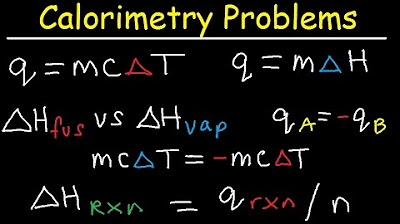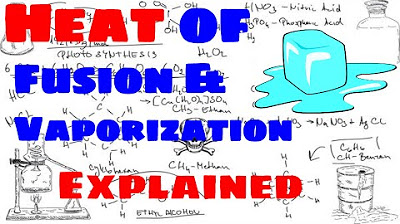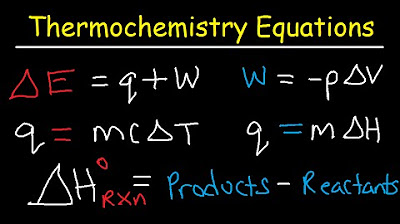Heats of Fusion & Vaporization
TLDRThis video script delves into the concepts of heat of fusion and heat of vaporization, highlighting the specific amount of heat required to melt or boil a substance, which varies based on the process. It explains that the heat of fusion is the heat needed to melt one gram of a substance, while the heat of vaporization is the heat needed to boil one gram. The script provides an example problem calculating the heat required to melt and then boil 400 grams of water, using the respective ΔHf and ΔHv values for water, emphasizing the importance of understanding these concepts in chemistry.
Takeaways
- 🔥 The script introduces the concepts of heat of fusion and heat of vaporization, emphasizing the specific amount of heat required to change the state of a substance.
- 🧊 The amount of heat needed to melt a 5-gram ice cube is different from that required to boil 5 grams of liquid water, highlighting the state-dependence of heat requirements.
- 🔬 In chemistry, the process of melting is referred to as fusion, and boiling is referred to as vaporization.
- 📊 The heat of fusion is defined as the amount of heat needed to melt one gram of a substance, while the heat of vaporization is the heat needed to boil one gram.
- 📚 Upper-level chemistry courses often express heats of fusion and vaporization in kilojoules per mole for stoichiometric calculations, not just per gram.
- ⚖️ The formula Q/m represents heat per gram, which is equivalent to the change in enthalpy (ΔH), and is used to calculate the heat of fusion (ΔHf) or vaporization (ΔHv).
- 🔢 The equations Q = mΔHf and Q = mΔHv are used to calculate the heat required for fusion and vaporization respectively, with different ΔH values for each process.
- 💧 Students are advised to memorize the heat of fusion and vaporization values for water, which are commonly used in chemistry, especially in the heat unit.
- 📈 An example problem demonstrates how to calculate the heat required to melt 400 grams of water using the formula Q = mΔHf, resulting in 133,600 joules or 133 kilojoules.
- 🔄 The same principle applies to boiling water, using the formula Q = mΔHv, with a different ΔH value, resulting in 904,000 joules or 904 kilojoules.
- 📝 Chemistry problems involving heat of fusion and vaporization are essentially algebraic, requiring knowledge of Q (heat), m (mass), and ΔH (enthalpy change) to solve for unknowns.
Q & A
What are heat of fusion and heat of vaporization?
-Heat of fusion is the amount of heat required to change a substance from solid to liquid state without changing its temperature, while heat of vaporization is the amount of heat needed to change a substance from liquid to gas state.
Why are the heat of fusion and heat of vaporization different for the same substance?
-They are different because the processes of melting (fusion) and boiling (vaporization) involve different amounts of energy to overcome the intermolecular forces and change the state of the substance.
What is the unit commonly used for expressing heats of fusion and vaporization in upper-level chemistry courses?
-In upper-level chemistry courses, heats of fusion and vaporization are often expressed in joules or kilojoules per mole, which allows for stoichiometric calculations.
How is the heat of fusion related to the concept of enthalpy?
-The heat of fusion is related to enthalpy as it represents the change in enthalpy (ΔH) when a substance undergoes a phase transition from solid to liquid.
What is the formula used to calculate the heat (Q) required for a phase transition?
-The formula used to calculate the heat (Q) required for a phase transition is Q = mΔH, where m is the mass of the substance and ΔH is the heat of fusion or vaporization per gram.
What does ΔH stand for in the context of phase transitions?
-In the context of phase transitions, ΔH stands for the change in enthalpy, which is the heat content of a system.
How can you determine the correct ΔH value to use for a phase transition?
-You determine the correct ΔH value to use by identifying whether the phase transition is a fusion (melting) or vaporization (boiling) and then using the corresponding ΔHf or ΔHv value.
What is the heat of fusion for water in joules per gram?
-The heat of fusion for water is approximately 334 joules per gram.
What is the heat of vaporization for water in joules per gram?
-The heat of vaporization for water is approximately 2260 joules per gram.
How much heat is required to melt 400 grams of water using the heat of fusion?
-To melt 400 grams of water, you would require 133,600 joules, which can be rounded to 100 kilojoules.
How much heat is required to boil 400 grams of water using the heat of vaporization?
-To boil 400 grams of water, you would require 904,000 joules, which can be rounded to 900 kilojoules.
What is the significance of significant figures in the context of the given example problems?
-Significant figures are important in the context of the example problems to ensure the precision of the result matches the precision of the given data, which in this case is one significant figure for the mass of water.
Outlines
🔥 Understanding Heat of Fusion and Vaporization
This paragraph introduces the concepts of heat of fusion and heat of vaporization, emphasizing that each substance has a specific amount of heat required to change its state. The speaker clarifies that the amount of heat needed to melt a 5-gram ice cube is different from that required to boil 5 grams of liquid water, highlighting the dependency on the process. The terms 'fusion' for melting and 'vaporization' for boiling are defined, and the heat of fusion is described as the heat needed to melt one gram of a substance, while the heat of vaporization is the heat needed to boil one gram. The paragraph also touches on the common practice in higher-level chemistry courses of expressing these values per mole for stoichiometric calculations, but focuses on the per gram basis for the video. An example problem is given to illustrate the calculation of heat required to melt 400 grams of water using the heat of fusion value for water.
📚 Calculating Heat for Melting and Boiling Water
The second paragraph continues with the theme of calculating the heat required for phase changes, specifically melting and boiling, using the heat of fusion and vaporization values. The speaker provides the values for the heat of fusion and vaporization of water, suggesting that students memorize these common values. An example calculation is shown to determine the heat needed to melt 400 grams of water, resulting in 133,600 joules or 133 kilojoules when rounded to one significant figure. The paragraph then contrasts this with the calculation for boiling the same mass of water, using the heat of vaporization value, which yields 904,000 joules or 904 kilojoules. The speaker concludes by noting that problems could vary, asking for different variables such as heat, mass, or the heat of fusion/vaporization, and emphasizes that solving these problems is a matter of algebra once the concepts of Q (heat), M (mass), and ΔH (heat of fusion/vaporization) are understood.
Mindmap
Keywords
💡Heat of Fusion
💡Heat of Vaporization
💡Specific Heat
💡Enthalpy
💡Phase Change
💡Mole
💡Stoichiometry
💡Mass
💡Joule
💡Kilojoule
💡Significant Figures
Highlights
Heat of fusion and heat of vaporization are fundamental concepts in understanding phase changes in substances.
Different substances require specific amounts of heat to melt or boil, which varies based on the phase change being induced.
In chemistry, melting is referred to as fusion, and boiling is referred to as vaporization.
Heat of fusion is the amount of heat needed to melt one gram of a substance.
Heat of vaporization is the amount of heat required to boil one gram of a substance.
Heats of fusion and vaporization are often expressed in kilojoules per mole for stoichiometric calculations.
The formula Q/m represents heat per gram, where Q is the heat and m is the mass.
ΔH (Delta H) represents the change in enthalpy, which is the heat content.
The formula Q = mΔH is used to calculate the heat required for phase changes, where ΔH can be for fusion (ΔHf) or vaporization (ΔHv).
Memorizing the heat of fusion and vaporization values for water is recommended due to its frequent use in chemistry.
The heat of fusion for water is 334 joules per gram.
The heat of vaporization for water is significantly higher at 2260 joules per gram.
An example problem demonstrates calculating the heat required to melt 400 grams of water using the formula mΔHf.
The calculated heat required to melt 400 grams of water is 133,600 joules, or 133 kilojoules.
Significant figures in calculations are crucial and should be adhered to based on the given data.
For boiling 400 grams of water, the formula mΔHv is used with the heat of vaporization value.
The calculated heat required to boil 400 grams of water is 904,000 joules, or 904 kilojoules.
Problems may vary by asking to solve for Q, m, or ΔH, which involves algebraic manipulation of the given formulas.
Understanding the concepts of heat of fusion and vaporization is essential for solving phase change problems in chemistry.
Transcripts
Browse More Related Video

Calorimetry Problems, Thermochemistry Practice, Specific Heat Capacity, Enthalpy Fusion, Chemistry

Specific heat, heat of fusion and vaporization example | Chemistry | Khan Academy

Latent Heat of Fusion and Vaporization, Specific Heat Capacity & Calorimetry - Physics

Heat of Fusion and Heat of Vaporization Explained

Thermochemistry Equations & Formulas - Lecture Review & Practice Problems

Chilling water problem | States of matter and intermolecular forces | Chemistry | Khan Academy
5.0 / 5 (0 votes)
Thanks for rating: